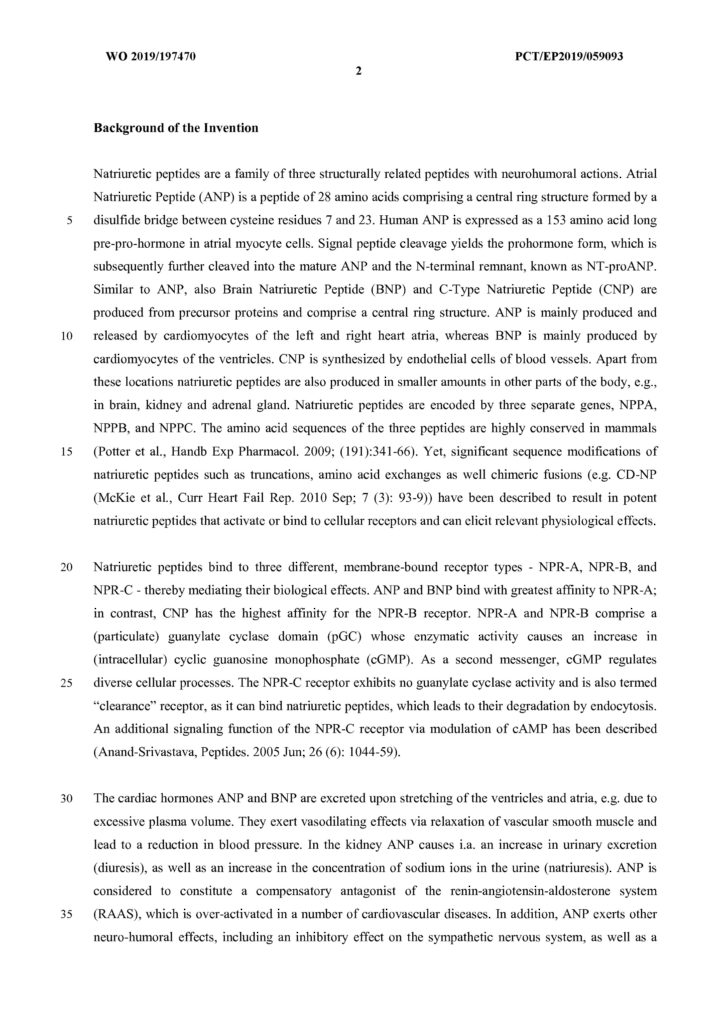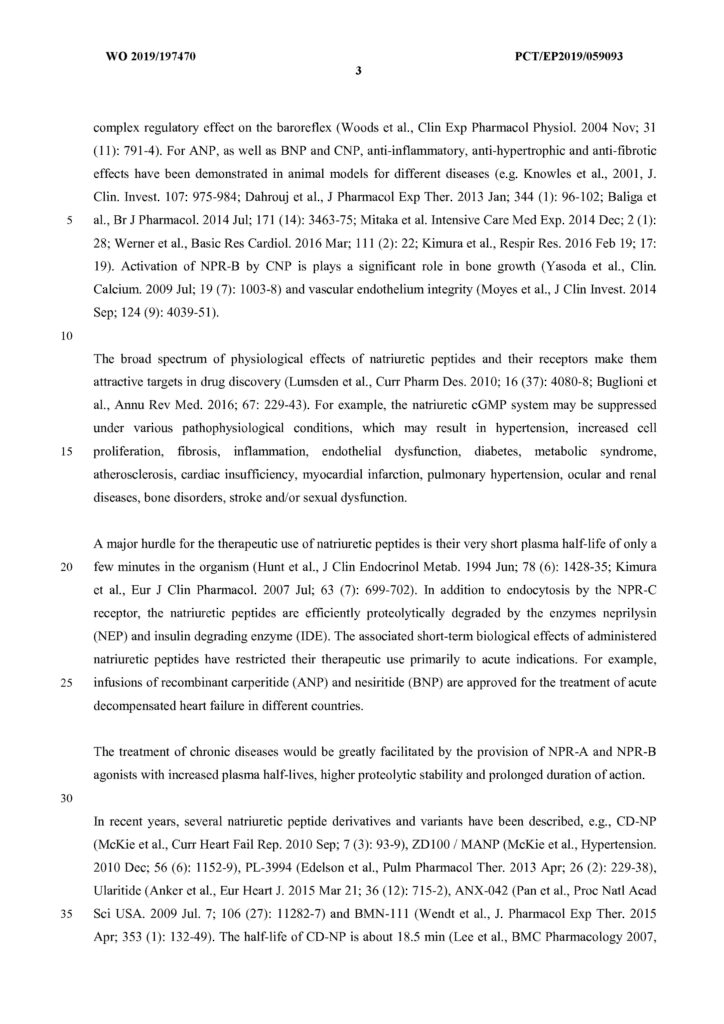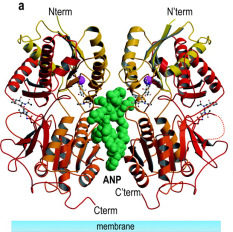Atrial natriuretic peptid (ANP) – UniProt P01160
Brain natriuretic peptide (BNP) – UniProt P16860
C-type natriuretic peptide (CNP) – UniProt P23582
„As drugs, both ANP and BNP, and derivatives of these peptides, seem promising as therapy in heart failure patients and in hypertension. Moreover, the cardiac peptide hormones may also possess organ-protective effects, where kidney function and cardiac remodeling seem in particular relevant.“
The Endocrine Heart.
de Bold, A.J., Burnett, J.C., Goetze, J.P. (2018).
In: Principles of Endocrinology and Hormone Action.
Belfiore, A., LeRoith, D. (eds)
Endocrinology. Springer, Cham. https://doi.org/10.1007/978-3-319-44675-2_20
Kollaboration – meine Beiträge
Design and analysis of peptide engrafted antibodies
- Protein Design – innovation
- Heavy and Light Chain Design – concept and feasibility
- Antibody-Peptide Designs – alternative embodiments
- Assays – expression, quantification, activity, ELISA, cell-based / HTRF assays, sample handling, data analysis, fitting, interpretation
- Isotype Changes – extension of the scope

Atrial natriuretic peptid (ANP) – UniProt P01160,
Brain natriuretic peptide (BNP) – UniProt P16860, und
C-type natriuretic peptide (CNP) – UniProt P23582


Summary of the Invention
The above stated object is achieved by the teaching of the subject independent claims. The present inventors have surprisingly found that biologically active natriuretic peptide variants with significantly increased stability in serum as compared to naturally occurring wild type natriuretic peptides can be obtained by incorporating a natriuretic peptide amino acid sequence into one of the CDR regions of an immunoglobulin molecule or a fragment thereof, despite the short length and high sequence conservation of immunoglobulin CDR regions, which impose considerable conformational restrains to the incorporation of biologically active peptides. However, the activity of natriuretic peptides incorporated within an immunoglobulin CDR region was shown to vary considerably. The present inventors have found that the decisive factor for a successful incorporation yielding a biologically active natriuretic peptide variant is the number of amino acid residues between the incorporated natriuretic peptide and the nearest neighboring CDR-framework junctions N-terminal and C-terminal from the incorporated natriuretic peptide. Below a certain number of N-terminal and C-terminal flanking amino acid residues between natriuretic peptide and neighboring CDR-framework junctions only natriuretic peptide immunoglobulin fusion constructs with no or drastically reduced biological activity were obtained. Specific linker sequences flanking the incorporated natriuretic peptide were found to be especially advantageous for achieving high peptide activity, good expression levels and/or low protein fragmentation levels.
Thus, in a first aspect, the present invention relates to an antibody or a fragment thereof comprising at least one heterologous amino acid sequence incorporated within at least one CDR region of said antibody or fragment thereof, wherein said at least one heterologous amino acid sequence comprises an N-terminal linker sequence (Ntls), a natriuretic peptide and a C-terminal linker sequence (Ctls), wherein optionally at least a portion of said at least one CDR region is replaced by said at least one heterologous amino acid sequence incorporated therein, and wherein
a) at least 12 amino acid residues are present between
i) amino acid residue HC res25 according to Kabat (in the heavy chain having the amino acid sequence of SEQ ID NO 65 this corresponds to res S25) and the first amino acid residue of the natriuretic peptide in case of an incorporation of said heterologous amino acid sequence within CDRH1;
ii) amino acid residue HC res51 according to Kabat (in the heavy chain having the amino acid sequence of SEQ ID NO 65 this corresponds to res I51) and the first amino acid residue of the natriuretic peptide in case of an incorporation of said heterologous amino acid sequence within CDRH2;
iii) amino acid residue HC res92 according to Kabat (in the heavy chain having the amino acid sequence of SEQ ID NO 65 this corresponds to res C96) and the first amino acid residue of the natriuretic peptide in case of an incorporation of said heterologous amino acid sequence within CDRH3;
iv) amino acid residue LC res26 according to Kabat (in the light chain having the amino acid sequence of SEQ ID NO 66 this corresponds to res S25) and the first amino acid residue of the natriuretic peptide in case of an incorporation of said heterologous amino acid sequence within CDRL1;
v) amino acid residue LC res49 according to Kabat (in the light chain having the amino acid sequence of SEQ ID NO 66 this corresponds to res Y51) and the first amino acid residue of the natriuretic peptide in case of an incorporation of said heterologous amino acid sequence within CDRL2; and/or
vi) amino acid residue LC res88 according to Kabat (in the light chain having the amino acid sequence of SEQ ID NO 66 this corresponds to res C90) and the first amino acid residue of the natriuretic peptide in case of an incorporation of said heterologous amino acid sequence within CDRL3; and wherein
b) at least 9 amino acid residues are present between the last amino acid residue of the natriuretic peptide and
i) amino acid residue HC res35a according to Kabat (in the heavy chain having the amino acid sequence of SEQ ID NO 65 this corresponds to res M34) in case of an incorporation of said heterologous amino acid sequence within CDRH1;
ii) amino acid residue HC res57 according to Kabat (in the heavy chain having the amino acid sequence of SEQ ID NO 65 this corresponds to res T58) in case of an incorporation of said heterologous amino acid sequence within CDRH2;
iii) amino acid residue HC res106 according to Kabat (in the heavy chain having the amino acid sequence of SEQ ID NO 65 this corresponds to res G111) in case of an incorporation of said heterologous amino acid sequence within CDRH3;
iv) amino acid residue LC res 32 according to Kabat (in the light chain having the amino acid sequence of SEQ ID NO 66 this corresponds to res D34) in case of an incorporation of said heterologous amino acid sequence within CDRL1;
v) amino acid residue LC res57 according to Kabat (in the light chain having the amino acid 20 sequence of SEQ ID NO 66 this corresponds to res G59) in case of an incorporation of said heterologous amino acid sequence within CDRL2; and/or
vi) amino acid residue LC res98 according to Kabat (in the light chain having the amino acid sequence of SEQ ID NO 66 this corresponds to res F102) in case of an incorporation of said heterologous amino acid sequence within CDRL3. In further aspects, the present invention relates to such antibody or fragment thereof for use in a method for treatment, a composition comprising such antibody or fragment thereof, a nucleic acid or a mixture of nucleic acids encoding such antibody or fragment thereof, a host cell comprising such nucleic acid or such mixture of nucleic acids and to a process for producing such antibody or fragment thereof.
WO2019197470A1
Example 1: Construction of candidate TPP-5661
Candidate TPP-5661 was designed by fusion of a heterologous amino acid sequence comprising a Ntls, wild type rat ANP and a Ctls to the C-terminus of HV 3-23 (SEQ ID NO 85) by substituting the two C-terminal residues of HV 3-23 by the two N-terminal residues of the heterologous amino acid sequence and to the N-terminus of IGHJ1 (SEQ ID NO 86) by substituting the nine N-terminal residues of IGHJ1 by the 9 C-terminal residues of the heterologous amino acid sequence. The corresponding full length heavy chain sequence of SEQ ID NO 67 further comprises amino acid sequence Constant-H (SEQ ID NO 87).Pairing of the full length heavy chain sequence of SEQ ID NO 67 harboring the inserted rat ANP (rANP) with the full length light chain sequence of SEQ ID NO 66 built by combining sequences LV 1-40 (SEQ ID NO 88), IGLJ2 (SEQ ID NO 89) and Constant-L (SEQ ID NO 90) yields the full IgG candidate TPP-5661 (see Table 1).
Shown below is the full length heavy chain sequence (SEQ ID NO 67); the incorporated heterologous amino acid sequence (Ntls-rANP-Ctls) is underlined; sequences derived from HV 3-23 and IGHJ1 are shown in bold:
EVQLLESGGGLVQPGGSLRLSCAASGFTFSSYAMSWVRQAPGKGLEWVSAISGSGGSTYYADSVKGRFTISRDNSKNTLYLQMNSLRAEDTAVYYCTSVHQETKKYQSSPDGGSGGSLRRSSCFGGRIDRIGAQSGLGCNSFRYGSYSYTYNYEWHVDVWGQGTLVTVSSASTKGPSVFPLAPSSKSTSGGTAALGCLVKDYFPEPVTVSWNSGALTSGVHTFPAVLQSSGLYSLSSVVTVPSSSLGTQTYICNVNHKPSNTKVDKKVEPKSCDKTHTCPPCPAPELLGGPSVFLFPPKPKDTLMISRTPEVTCVVVDVSHEDPEVKFNWYVDGVEVHNAKTKPREEQYNSTYRVVSVLTVLHQDWLNGKEYKCKVSNKALPAPIEKTISKAKGQPREPQVYTLPPSRDELTKNQVSLTCLVKGFYPSDIAVEWESNGQPENNYKTTPPVLDSDGSFFLYSKLTVDKSRWQQGNVFSCSVMHEALHNHYTQKSLSLSPG
WO2019197470A1
Example 4: Generation of different NP engrafted antibody constructs
For constructs with a natriuretic peptide incorporation in a CDR region other than CDRH3 a presumably functionally neutral CDRH3 was designed by fusion of the three residues stretch Leu Thr Gly (IGHD7-27*01) to the C-terminus of HV 3-23 and the N-terminus of IGHJ1 (compare Example 1). The corresponding full length heavy chain sequence of SEQ ID NO 65 further comprises amino acid sequence Constant-H (SEQ ID NO 87).
Pairing of the full length heavy chain sequence of SEQ ID NO 65 without any natriuretic peptide insertion with the full length light chain sequence of SEQ ID NO 66 described in Example 1 yields the synthetic and presumably neutral IgG negative control TPP-5657.
The designed and synthesized antibody construct was cloned according to well-known methods in the art and confirmed by DNA sequencing using plasmid specific oligonucleotides.
Starting from this antibody scaffold, the following ANP engrafted antibody constructs were generated.
{Es folgen Tabellen mit Informationen zum Design von 209 „ANP engrafted antibody constructs„, 6 „BNP engrafted antibody constructs“ und 12 „CNP engrafted antibody constructs“.}
WO2019197470A1
Example 5: In vitro activities of generated constructs All constructs were expressed transiently in HEK293 cells according to well-known methods in the art, targeting a cell density of about 2×10^6 cells/ml, a total DNA concentration of about 1µg/ml for the two plasmids encoding the light and heavy chain and a 5 day incubation for the expression.
Raw compound samples (rcs) were expressed in a culture volume of 0.4ml, and the supernatan separated by centrifugation was directly used for testing. The compound concentration was assessed by an IgG-Fc quantification ELISA according to well-known methods in the art. Briefly, 1:1500 diluted supernatant and a 2-fold dilution series of Human Reference Serum (Bethyl, RS-110-4) starting with 400ng/ml were immobilized in black Maxisorp 384 micro titer plates (MTP) coated with anti-human Fc [Sigma I2136] in a 1:440 dilution in 1x coating buffer (Candor, 121125) for 1h, 37°C. After blocking with 100% SMART Block (Candor, 113125) anti-human Fc-HRP [Sigma, A0170] was applied in a 1:10000 dilution for the detection of antibodies in rcs and reference samples. Dose curves of the reference sample were used for the quantitative assessment of compound concentrations shown in Table 7, column “µg/ml rcs”. All samples were applied in quadruplets.
Isolated compound samples (ics) were generated by 1-step purification via protein-A from 6 ml expression culture and according to well-known methods in the art. Acid eluates were neutralized by addition of 8% (v/v) 1M Tris/HCl pH 9.0, quantified via absorption at 280nm and normalized to a concentration of 125nM.
Purified compound samples (pcs) were generated by 2-step purification via protein-A and subsequent SEC in PBS buffer from expression culture of at least 35ml. Values shown in Table 7, column “µg/ml pcs”, refer to the compound concentration in the expression culture supernatant determined by analytical Protein A chromatography.
All activities shown in Table 7 were measured on cells with heterologous over expression of human NPRA (hNPRA) by use of a cGMP quantification assay conducted according to manufacturer’s instructions (cisbio; 62GM2PEH). In brief, the assay quantifies cGMP in buffered solution or cell– culture supernatants based on the competition between cGMP produced by the cell as result of the NPRA stimulation through the (natriuretic peptide) sample and d2 labelled cGMP for binding to a Cryptate labelled antibody. Sample cGMP and d2 labeled cGMP compete for binding to a limited number of sites on Cryptate labeled anti-cGMP antibodies, and consequently, HTRF® specific fluorescent signal (i.e. energy transfer) is inversely proportional to the concentration of cGMP in the sample.
Dose-response curve data were analyzed with GraphPad Prism (version 7.00 for Windows, GraphPad Software, La Jolla California USA) and EC50 were fitted according to
Y=Bottom + (Top-Bottom)/(1+10^((LogEC50-X)*HillSlope)) applying constraints for bottom, top and slope (shared value for all data sets of the respective experiment).
The raw compound sample activity on stable hNPRA-CHO k1 cells was first assessed by comparison to the negative control TPP-5657 and to a positive sample, in particular TPP-5661. Controls and rcs were tested in quadruplets in two concentrations with a relative dilution factor of 5 aiming for a fluorescent signal (s) in the dynamic range of the assay. The assay window was defined as the difference in signal of inactive (max. signal, s_max) and highly active samples (min. signal, s_min), and for both compound concentrations the activity in % was calculated as 100(s_max – s) / (s_max – s_min). Values listed in Table 7, columns “activity rcs” and “stdev activity rcs“, represent the average of the results for the two concentrations and the respective standard deviation. Rcs signals less than half of the signal of the reference compound TPP-5661 (36%) were assessed as not active (n.a.).
The activity of several raw compound samples on stable hNPRA-CHO k1 cells was reassessed by comparison to reference sample TPP-5661 in 2.5-fold dilution series (8 concentrations) starting with a 5-fold dilution. The “logEC50” fit value as activity measure of the rcs was set in relation to the corresponding value of the reference rcs TPP-5661 by calculating the delta “logEC50”_compound – “logEC50”_TPP-5661; resulting values are listed in Table 7, column “rel. activity rcs”. Notably, the compound concentrations in the rcs was not considered, and consequently given values are influenced by compound activity and concentration in equal measure. All samples were applied in quadruplets.
The activity of isolated compound samples on stable hNPRA-CHO k1 cells was assessed by EC50 determination and comparison to reference sample TPP-5661. Samples were tested in 2.5-fold dilution series from 80nM to 0.13nM. The logEC50 fit value as activity measure of the ics was set in relation to the corresponding value of the reference ics TPP-5661 (-8.8) by calculating the delta logEC50_compound – logEC50_TPP-5661; resulting values are listed in Table 7, column “rel. logEC50 ics”. All samples were applied in quadruplets.
The activity of purified compound samples on stable hNPRA-CHO k1 cells was assessed in multiple experiments by EC50 determination and comparison to reference sample TPP-5661. Samples were tested in dilution series at least in quadruplets. Values listed in Table 7, columns “rel. logEC50 pcs 1, 3 and 4” result from 5-fold dilution series (≥4 concentrations) starting with 20 or 25nM. Values listed in Table 7, column “rel. logEC50 pcs 2” result from 10-fold dilution series (4 concentrations) starting with 25nM. Values listed in Table 7, columns “rel. logEC50 pcs 5, 6, 7, 8 and 9” result from 2.5-fold dilution series, with 8 or 12 concentrations starting with 40 to 200nM, respectively. The logEC50 fit value as activity measure of the pcs was set in relation to the corresponding value of the reference TPP-5661 in the respective experiment (in average -9.2, standard deviation 0.5) by calculating the delta logEC50_compound – logEC50_TPP-5661.
The activity of purified compound samples on transient hNPRA-HEK293 cells was assessed in three experiments by EC50 determination and comparison to reference sample TPP-5661. Samples were tested in 5-fold dilution series from 1000nM to 0.013nM. The logEC50 fit value as activity measure of the pcs was set in relation to the corresponding value of the reference TPP-5661 in the respective experiment (average of three experiments -9.0, standard deviation 0.4) by calculating the delta logEC50_compound – logEC50_TPP-5661; resulting values are listed in Table 7, columns “rel. logEC50* pcs”. All samples were applied in duplicates.
A summarized qualitative assessment of the activity of compounds is given in the column “qualit. activity”, values listed in column “average rel. logEC50” were calculated as average of given rel. logEC50 values. Compounds showing an EC50 values >50-fold of the reference compound TPP-5661, meaning average rel. logEC50 > 1.7, were qualitatively assessed as not active (“ – “), compounds showing a relative logEC50 between 0.7 and 1.7 were assessed as active (“ + “), compounds showing a relative logEC50 < 0.7 were assessed as very active (“ ++ “); highest activities were observed at relative logEC50 below -0.7 (“ +++ “). Compounds showing an activity in rcs without confirmation as ics or pcs are marked with an unified “ y “, and compounds assessed as not active (“n.a.” in column “activity rcs“) probably due to their very low expression level (≤1 µg/ml, “n.e.” in column “µg/ml rcs”) are marked accordingly.
{Es folgt „Table 7: Expression levels and activities of natriuretic peptide engrafted antibody constructs“}
WO2019197470A1
Example 6: Specific linker sequences are particularly advantageous for achieving good homogeneity and expression levels
The purity of purified compound samples (Example 5, Table 7, column “% purity pcs”) was determined by capillary Gel Electrophoresis according to manufacturer’s instructions (LabChip GX, Caliper Life Sciences) under reduced conditions. The purity in % was calculated as sum of peak areas corresponding to the intact light and heavy chain relative to the sum of all peaks observed.
Ntls sequences comprising a GS linker sequence, a PN linker sequence or the sequence of SEQ ID NOs 2, 4, 9, 11, 13 or 15 and Ctls sequences comprising a GS linker sequence, a PN linker sequence or the sequence of SEQ ID NOs 3, 5, 12, 14, 15 or 20 have proven particularly useful as they not only achieve high natriuretic peptide activities (provided that at least 12 amino acid residues are present between the respective N-terminal reference amino acid residue and the first amino acid of the inserted natriuretic peptide) but also good expression levels (in contrast to e.g., sequences used in compounds #186, #195 and #202) and (in contrast to e.g., sequences used in compounds 6 and 7) a low degree of inhomogeneity (see Table 8). With linker sequences comprising a GS linker sequence as well as linker sequences comprising a PN linker sequence very good purities of 98% in average were observed. Similarly good values were observed for compounds with linkers comprising sequences of SEQ ID NOs 2, 3, 4, 5, 9, 11, 12, 13, 14, 15 and 20. Notably, the Ntls having the sequence of SEQ ID NO 9 resulted only in combination with the Ctls having the sequence of SEQ ID NO 20 in compounds with very good purity; compounds with a combination of the Ntls having the sequence of SEQ ID NO 11 and the Ctls having the sequence of SEQ ID NO 12 showed only very good purity when SEQ ID NO 11 was flanked by Asp (D) on the N-terminal side and not by Thr (T) or Val (V) and when the SEQ ID NO 12 VNHLRSEKLT was flanked by Gly (G) on the C-terminal side but not by Tyr (Y) or Phe (F) as in compounds #126 and #135.
{Es folgt „Table 8: Ntls and Ctls effects on antibody purity (excerpt of Table 7)“}
WO2019197470A1
Example 7: IgGl, IgG2 and IgG4 isotypes provide equally suitable antibody scaffolds
Compounds 9, 33, 65, 91, 127 and 191 (human IgGl TRR-10294, TRR-10277, TPP-10279, TPP-10282, TPP-10269 and TPP-10355, respectively) were generated as different IgG isotypes. Purified compound samples were tested as described in Example 3 in quadruplets in dilution series on stable hNPRA-CHO kl cells. The activities of ANP engrafted human IgG2 and IgG4 isotype constructs (e.g. compound 9 IgG4 TPP- 10992) are similar to their corresponding IgGl isotype as graphically depicted in Figure 12.
WO2019197470A1
Example 8: Human and non-human IgGs provide equally suitable antibody scaffolds
Compound 9 (human IgGl TPP- 10294 and IgG4 TPP- 10992) and compound 117 (human IgGl TPP- 5665) were generated as non-human IgG isotypes. Purified compound samples were tested as described in Example 3 in quadruplets in dilution series on stable hNPRA-CHO kl cells. ANP engrafted rat and mouse isotype constructs, e.g. compound 9 rat IgGl TPP-13992, showed activities similar to their corresponding human IgG isotype (Figure 13).
WO2019197470A1
Example 9: Human IgGs comprising varying germline sequences provide equally suitable antibody scaffolds
22 additional ANP engrafted IgG4 antibodies (compounds A to S) were constructed. In each case ANP was incorporated within CDRH1. The heavy chains of these constructs comprise varying HV and CDRH3 sequences and were paired with varying lambda or kappa light chains. The structure of compounds A to S is summarized in Tables 10 and 11.
WO2019197470A1

